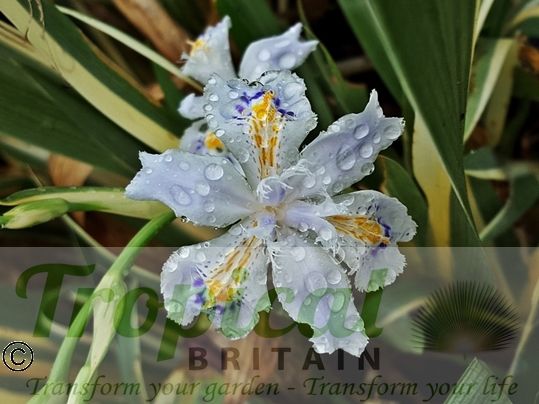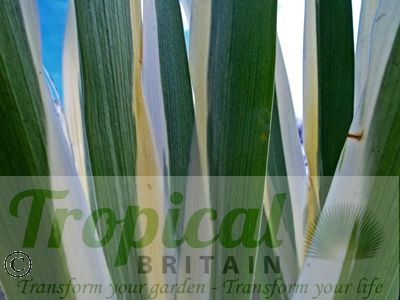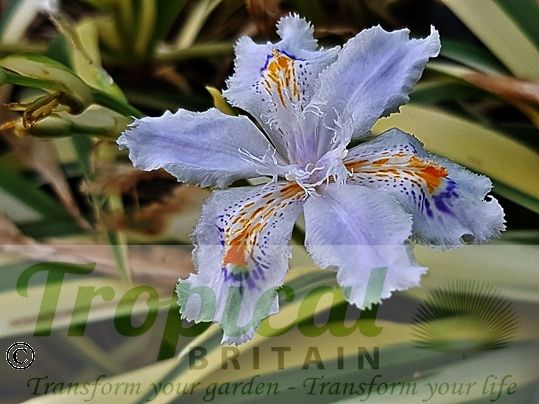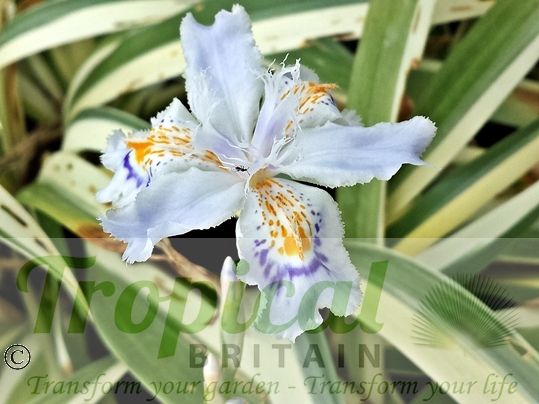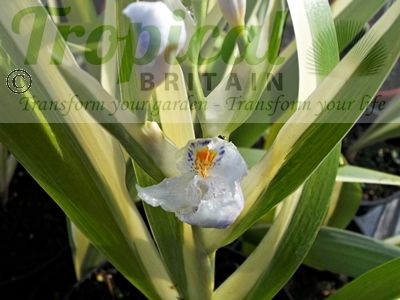Iris japonica 'Variegata'
A strikingly bold architectural foliage plant, Iris japonica 'Variegata' is a very attractive horticultural cultivar with broad fans of dark-green sword-like leaves with a creamy-white, ivory or pale yellow variegation that typically runs down the edges of the leaves forming wide margins. It has small, very delicate and fringed, orchid-like flowers that are white with purple and orange markings. Floating above the foliage on thin stems, they are called Butterfly Flowers by the Chinese.
Iris japonica, the type species, is found throughout Asia from Japan, through China to Myanmar and was first named by Carl Peter Thunberg, the Swedish botanist in his 1784 publication, 'Flora Japonica'. Thunberg, who was the foremost of Linnaeus' "Apostles" and arguably the greatest botanical explorer and collector of his day, had been commissioned to collect specimens for Dutch botanical gardens and after three years collecting in South Africa had set sail via Java for Japan, then an extremely closed society and virtually inacessible to foreigners. In 1775, he arrived at Dejima, a tiny artificial island in the harbour at Nagasaki that as the site of a Dutch trading factory was the only place foreigners were permitted. He stayed for fifteen months and despite the severe restrictions placed upon travel and collecting was able to gather enough information to publish 'Flora Japonica' upon his return to Europe. However, much of the material he described would have been from cultivated gardens and some from naturalised plants introduced into Japan from China. Such was possibly the case with Iris japonica, the first specimen of which reached the British Isles from Canton.
It is not always clear who first introduced various species into the UK and Iris japonica may have been originally introduced by either Dr John Duncan or his younger brother, Dr Alexander Duncan, both East India Company surgeons based in Canton, who, as correspondents of Sir Joseph Banks, regularly sent botanical consignments to Kew. Iris japonica is first recorded as being grown at Kew in 1792, however its original introduction is usually attributed to Thomas Evans, (b.1751 - d.1814).
Evans was an interesting character in the history of exotic gardening in the UK. From humble beginnings, he was originally a clerk in the Treasury Department of the East India Company and was based at East India House, on Leadenhall Street. He had a highly-commendable passion for growing rare and exotic plants and through the offices of the company he developed several contacts in Canton and amassed a considerable collection which he housed in greenhouses that he built in the garden of his house in Crombie's Row in Stepney. Sir James Edward Smith, in his 1804 book, 'Exotic Botany', mentions Evans in a description of Cymbidium hyacinthinum (a synonym of Bletilla striata): 'A native of the island of Trinidad, for which we are obliged to our liberal friend Thomas Evans Esq., of the East India House, in whose choice collection it first flowered in the autumn of 1803.' Now, as I'm sure you know, Bletilla striata comes from Asia not Trinidad so Sir James got that just a little bit wrong. And in her wonderful book, 'Gifts from the Gardens of China', Jane Kilpatrick describes at length the remarkable botanical enthusiasm of Thomas Evans.
As well as Iris japonica and the root-hardy Begonia grandis ssp. evansiana (now taxonomically Begonia grandis), Evans was responsible for the introduction to the UK of Ardisia crenata, the aforementioned Bletilla striata, Michelia figo, Musa cocchinea, Reineckia carnea, Rosa multiflora var. carnea and Rubus roseifoliaus 'Coronarius'.
In previous taxonomical classifications the crested Iris had been known both as Iris evansia and Evansia chinensis. Richard Anthony Salisbury, the British botanist who had opposed the Linnaen system, renamed Iris japonica in 1812 as Evansia chinensis, to honour Thomas Evans. Salisbury, the first honourary secretary of the RHS, was a controversial character in British botanical history and most of his generic names have been overturned. An extract from page 297 of the 1886 'Journal of Botany, British and Foreign', cites: "there was a tacit understanding on the part of the botanical leaders of the period, including Brown, Banks and Smith, that Salisbury's botanical work and names should, as far as possible, be ignored."
In 1913, W. R. Dykes in his monograph, 'The Genus Iris', returned Evanisia to the genus Iris. Today the members of subgenus Limniris subsection Lophiris - to which Iris japonica belongs - are collectively still known as Evansia irises.
Iris japonica 'Variegata' is an easy Iris in cultivation but not as hardy as other more common Irises. It should be planted in a sheltered spot, in full sun or half-shade in a moist, well-drained rich soil and fed regularly during the growing season. Its rhizomes prefer to be half-exposed above the soil so a thick mulch during the winter months will help to protect them from the frost.
Additional Information
| Order | Asparagales |
|---|---|
| Family | Iridaceae |
| Sub-Family | Iridoideae |
| Synonyms | Iris chinensis, Evansia chinensis, Evansia fimbriata, Iris fimbriata, Iris squalens, Iris japonica subsp. japonica var. typica, Iris japonica subsp. dalica, Iris japonica f. pallescens, Iris tectorum variegata 'Cruella', |
| Geographical Origin | Horticultural cultivar - type species from Asia: China, Japan, Myanmar |
| Cultivation | Full sun or damp semi-shade. A warm sheltered spot. Moist rich well-drained soil. Mulch well in winter |
| Eventual Height | 40 cm |
| Eventual Spread | 40 cm |
| Hardiness | May need protection during very cold spells. Rhizomes should be mulched for protection |

Free DELIVERY
ON ALL ORDERS OVER £99THIS OFFER IS VALID ON ALL OUR STORE ITEMS.

